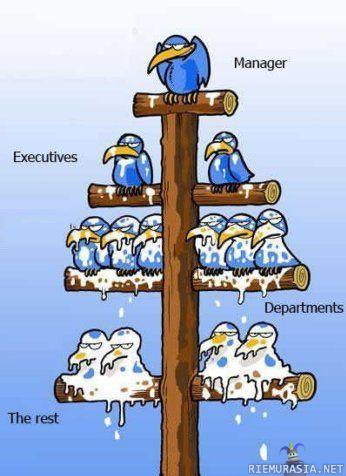/me catches up
Okay
Chris Avellone the penny finally drops on your "clear hierarchy" stuff. You're not demanding it so you can make underlings do their thing. You're demanding it to stop higher-ups from interfering in specifically delegated responsibilities.
That makes a lot more sense. I still think it's fundamentally misguided but it makes sense in context. From where I'm at Obsidian doesn't need an org chart: it needs new top management, rigorous factory-floor practices, and /then/ clearly-defined roles and responsibilities. But if your org chart has more than three levels in it, you're fucked from the start.
That is misguided, and I don't agree with it at all, I do want underlings (and sub-leads) to do their thing - and unfortunately, in my hierarchy, every superior above you in fact has the
right (but arguably shouldn't do it too much otherwise you undermine the people below you) to override anyone beneath them but they should check with the lead first before requesting a change (if only to make sure they understand the whole situation - there may be a reason something they disapprove of is done a certain way).
And even people on the lowest rings of the totem pole who are told "no" by their direct boss but still consider their opinion important to make the game better, can still go above their direct boss and bring it up the chain - provided you talk to your immediate boss first about the issue clearly, otherwise you're kind of throwing them under the bus by going to
their boss. I did a presentation on hierarchies (at Digital Dragons, I think?) about why I felt hierarchies were important and what I thought was to be gained by them, but it wasn't to stop people from being active or to protect underlings/create fiefdoms - it was to make responsibilities clearer across the team and empower people in all roles. Also, I felt the higher up the chain, the more focused you should be on your own ability to make things happen for the betterment of the project which a junior designer may not feel able to do.
My hierarchy is also done partially so everyone knows who to go to when there's a problem, and that people in sub-lead and lead roles know they are empowered to solve problems in their discipline by default (for example, a Lead Level Designer would know by default they should be the one setting optimization guidelines for their level designers, checking their work, and so on) if that makes sense. If roles aren't appointed, it's true that some people will simply do things, but it's much better (imo) if you give people responsibilities, goals, and then step back. If you've hired the right people, you're good to go. I know this may sound naive, but I think it's very important for momentum and saving time, especially when time is always at a premium.















![Glory to Codexia! [2012] Codex 2012](/forums/smiles/campaign_tags/campaign_slushfund2012.png)











